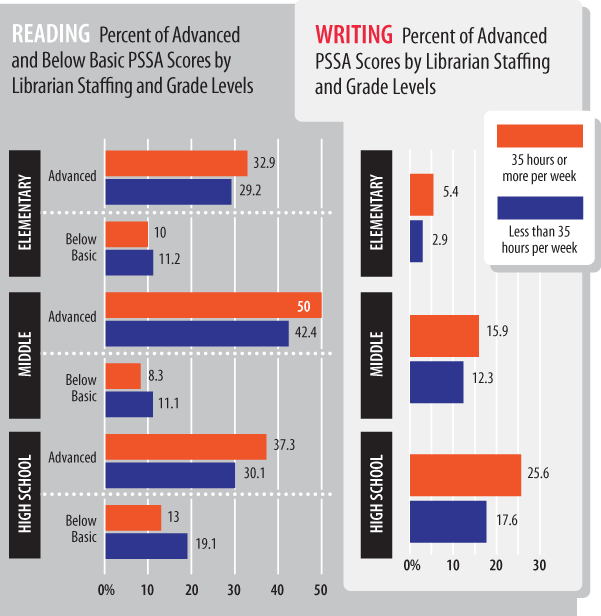Latest Study: A full-time school librarian makes a critical difference in boosting student achievement

Illustration by David Flaherty.
Imagine trying to teach kids how to swim in an empty pool.
That’s exactly what Baruch Kintisch envisioned when he took a hard look at the effects of his city’s deep education cuts. Philadelphia’s “schools are underfunded; classrooms are crowded; libraries, labs, and special-education services are outdated or nonexistent,” writes Kintisch, the director of policy advocacy and a senior staff attorney at the Education Law Center (see the Philadelphia Inquirer’s “City Schools’ Real Problem,” August 9, 2012).
Simply put, students suffer when they don’t have adequate resources—and, in particular, we’ve found that student achievement suffers when schools lack libraries that are staffed by full-time librarians. “Nearly every public school in Bucks, Delaware, and Montgomery Counties has a library with certified staff, which has been proven to increase student reading and comprehension,” notes Kintisch. “In contrast, most public schools in Philadelphia do not employ a certified librarian, and more than 140 do not have a library.”
He’s right. More than half of Philadelphia’s public schools are currently without a library. And according to the recent Pennsylvania School Library Study, a comprehensive study of school library services in publicly funded K–12 schools, 56 percent of the state’s schools don’t have a full-time school librarian. During the current school year, 2012–2013, the School District of Philadelphia, the state’s largest district, provided only 17 percent of its schools with professional librarians—that’s an anemic 43 of 249 schools. The picture is almost as bleak in the Pittsburgh School District, where just 27 percent of schools have full-time librarians—or a measly 14 out of 51 schools. Yet that hasn’t deterred many districts from getting rid of media specialists.
Even wealthy suburban districts find library reductions acceptable. For example, Manheim Township in Lancaster County, PA, has slashed librarian positions by 80 percent since 2010, going from 10.5 to 2.5 media specialists. At the same time, other districts employ full-time librarians in every building, many with support staff and annual budgets that enable them to update their collections and technology. How do these inequities affect teacher effectiveness and student achievement? And why is the research that shows the impact of quality school library programs and librarians on students being ignored?
Background
In 2007, when the trend to cut library programs and staffing became apparent to us, the Pennsylvania School Librarians Association (PSLA) teamed up with the Education Law Center (ELC), a nonprofit educational advocacy organization that has made substantial gains for the state’s most vulnerable children—including poor kids, kids of color, kids with disabilities, English-language learners, and others. PSLA and ELC discovered that they had many similar interests and goals, including a strong urge to ensure a quality public education for every child. The two groups began to lobby for statewide regulations and reforms to ensure library equity for Pennsylvania’s 1.8 million K–12 students.
 When representatives of the two organizations approached influential state legislators, they quickly discovered that some lawmakers didn’t know that schools weren’t required to have libraries, and others had no idea how rapidly these programs were being eliminated. Among many legislators’ first questions were, “How many schools do not have libraries or librarians?” and “How do school librarians improve student achievement and by how much?” Clearly, research and verifiable data were needed to influence these policymakers.
When representatives of the two organizations approached influential state legislators, they quickly discovered that some lawmakers didn’t know that schools weren’t required to have libraries, and others had no idea how rapidly these programs were being eliminated. Among many legislators’ first questions were, “How many schools do not have libraries or librarians?” and “How do school librarians improve student achievement and by how much?” Clearly, research and verifiable data were needed to influence these policymakers.
In the absence of data to answer their questions, PSLA persuaded the state’s House of Representatives to commission the Pennsylvania School Library Study of 2011—a “snapshot” of library programs in which 73 percent of public schools participated. While the study uncovered huge inequities among various districts, according to PSLA surveys, school library programs and staff have continued to be cut. For instance, in 2011–2012, an additional seven percent of librarians were let go, and, in 2012–2013, another six percent were jettisoned. As a result, “almost 200,000 students have been affected by elimination or severe curtailment of school library services throughout the Commonwealth,” says PSLA’s president, Eileen Kern.
Research and key findings
Joining forces with the Education Law Center and the Health Sciences Library Consortium (a nonprofit group that manages ACCESS PA and POWER Library electronic databases), PSLA was awarded an Institute of Museum and Library Services (IMLS) National Leadership research grant to determine what school library infrastructure contributes most to student achievement, the costs and benefits associated with it, and what’s needed to develop students with 21st-century learning skills. Although more than two decades of similar research has been conducted in over 22 states, the Pennsylvania study uncovered the following new and significant findings:
Quality school library programs significantly impact the most vulnerable students. For the first time, the impact of library programs on selected student groups that tend to experience achievement gaps was examined directly. The Pennsylvania System of School Assessment (PSSA), which measures how well schoolchildren are doing in reading, writing, math, and science according to the state’s education standards, maintains separate test scores for subgroups of students who are economically disadvantaged, black, Hispanic, and have Individualized Education Programs (IEPs). PSSA scores range from “Advanced,” which indicates an in-depth understanding of the subject and superior academic performance, to “Below Basic,” which reflects poor understanding and inadequate academic performance.
Consistently, reading and writing scores are better for students who have a full-time certified librarian than those who don’t. Students who are economically disadvantaged, black, Hispanic, and have IEPs (i.e., students with disabilities) benefit proportionally more than students generally. These findings suggest that staffing libraries with certified librarians can help close achievement gaps. What are some of the other key findings?
• Students who are poor, minority, and have IEPs, but who have full-time librarians, are at least twice as likely to have “Advanced” writing scores as their counterparts without full-time librarians.
• Generally, the benefits associated with larger staffing and collections and increased access to technology, databases, and to the library itself are proportionally greater for students who are poor, black, Hispanic, and disabled.
• For black and Hispanic students, access to more books more than doubles their chances of obtaining “Advanced” writing scores and cuts their risk of “Below Basic” writing scores in half.
• The association between flexible scheduling and writing scores is more pronounced. With flexible scheduling, all students are about four times more likely to earn “Advanced” writing scores, and Hispanic students are almost seven times more likely to earn “Advanced” scores with flexible scheduling.
Writing scores are more positively impacted than reading scores. Since 21st-century learners must be effective knowledge producers as well as information consumers, examining the relationship between writing scores and quality school library programs was essential. Writing scores of students were studied at both the “Advanced” and “Below Basic” levels. Interestingly, the impact of school library programs was greater proportionally on writing than reading scores. Students with access to well-resourced libraries are two to five times more likely to score “Advanced” in writing than students without such libraries. Other significant findings include:
• For all students, those with full-time librarians are almost three times as likely to have “Advanced” writing scores as students without full-time librarians.
• The differential impact of librarians suggests that writing rather than reading scores may be a better indicator of a student’s mastery of 21st-Century Learner and Pennsylvania/Common Core standards.

The role of the school library program and academic standards. This is the first statewide study to assess the roles of librarians in teaching the American Association of School Librarians’ (AASL) Standards for the 21st-Century Learner as well as Common Core standards. We and our associates at RSL Research Group in Louisville, CO, surveyed more than 1,850 librarians, teachers, and school administrators to determine the extent to which these standards are addressed by school library programs and the instruction by librarians. To verify their perceptions, survey results were then correlated with the reading and writing scores of the respondents’ schools. This study provides the first evidence that what librarians teach both addresses academic standards and impacts students’ standardized test scores.
• These relationships are especially strong for the Pennsylvania/Common Core standards for English language arts and reading and writing for history and social studies.
• Notably, the positive association of the librarian’s role in teaching AASL’s Standards for the 21st-Century Learner with “Advanced” writing scores is dramatically higher than with “Advanced” reading scores.
• Consistently, students are less likely to score “Below Basic” on reading and writing in schools in which administrators, teachers, and librarians assess as “excellent” the library program’s teaching of inquiry-based learning.
As Carol Heinsdorf, a National Board–certified school librarian at Philadelphia’s Youth Study Center High School, explains, “These nationally adopted academic aspirations, supported by empirical evidence of school librarians’ effectiveness, are at odds with the 87 percent of Philadelphia’s incoming ninth graders who have never experienced an adequately resourced school library managed by a certified librarian, don’t know how books are arranged on a library shelf, do not know to, or how to, cite sources, and have not read a book from beginning to end for either academic purposes or pleasure. How are these students being prepared to successfully complete a two- or four-year college program? How are they to be reading role models as their children’s first teachers? How are those policy and decision makers shepherding public education as a public good for the future of our democracy going to prioritize adequately resourced school libraries managed by certified school librarians, to align with the evidence?”
Staffing remains the key factor. This study suggests that there’s no substitute for a full-time, certified school librarian who’s fully engaged in the teaching and learning process. Key findings include:
• With a full-time librarian, students are more likely to score “Advanced” and less likely to score “Below Basic” on reading and writing tests.
• Consistently, reading scores are better for elementary, middle, and high school students who have full-time certified librarians. In schools with full-time librarians, “Below Basic” scores not only improve, but improve more from elementary to middle to high school as well.
• The proportional difference in “Advanced” reading scores associated with a full-time librarian grows from elementary to middle to high school.
• Students who are Hispanic and whose full-time librarians have support staff are three times as likely to earn “Advanced” writing scores as their counterparts whose full-time librarians lack such support staff.
• On average, almost nine percent more students score “Advanced” in reading where students have a full-time, certified librarian with support staff than where they have a full-time, certified librarian alone. Further, almost eight percent more students score “Advanced” in reading where students have a full-time, certified librarian than where they do not.
• On average, the percentage of students scoring “Advanced” in writing is two and a half times higher for schools with a full-time, certified librarian than those without one. Similarly, the average percentage of students scoring “Advanced” in writing is almost twice as high for schools with a full-time, certified librarian with support staff as for those with only a full-time certified librarian.
As Jessie B. Ramey, a parent of two Pittsburgh public school students, wrote on her educational advocacy blog, Yinzercation, “Without a full-time librarian in each of our schools, we are still short-changing our kids…. As this most recent study clearly found, librarians are even more significant for our most struggling students, yet these are often the very kids forced to go without books, staff, or space.”
We couldn’t agree more. Of all the factors examined in this study, the one with the most impact on students is the presence of a full-time certified librarian in the school library.
Conclusion
This study adds to the evidence that all K–12 students need and deserve quality school library programs with full-time certified staff. Students are more likely to succeed when they have library programs that are well staffed, well funded, technologically well equipped, well stocked, and more accessible. And, the neediest learners may benefit the most from trained librarians and quality library programs.
However, much work still needs to be done to use this research to reach influential stakeholders who control the future of school library programs and their staffing. While many states are pursuing state reforms and regulations, this doesn’t negate the role of the individual school librarian to learn and share these findings locally. Everyone needs to nurture library champions who will defend the position that all K–12 school students need and deserve full-time school librarians and well-resourced school libraries in order to develop the skills needed to be productive in the 21st century.

 Debra E. Kachel teaches online library science and technology courses at Mansfield (PA) University. Keith Curry Lance is a consultant with the RSL Research Group in Louisville, CO. To read a complete report of the study, see Pennsylvania School Libraries Pay Off: Investments in Student Achievement and Academic Standards. The research was presented at SLJ’s 2012 Leadership Summit.
Debra E. Kachel teaches online library science and technology courses at Mansfield (PA) University. Keith Curry Lance is a consultant with the RSL Research Group in Louisville, CO. To read a complete report of the study, see Pennsylvania School Libraries Pay Off: Investments in Student Achievement and Academic Standards. The research was presented at SLJ’s 2012 Leadership Summit.
RELATED
The job outlook in 2030: Librarians will be in demand
The job outlook in 2030: Librarians will be in demand
ALREADY A SUBSCRIBER? LOG IN
We are currently offering this content for free. Sign up now to activate your personal profile, where you can save articles for future viewing






Add Comment :-
Comment Policy:
Comment should not be empty !!!
Jeff
Another great SLJ issue! I think that what Lance and Kachel share in their article is really nothing new, nor groundbreaking in any sense of teacher-librarianship research and advocacy. We KNOW that TLs matter to achievement in schools. WE—teacher-librarians and our few external advocates—but that’s about it. But here’s the real problem: we don’t have the ears of those we need to have. We need to get these articles and this research into the journals of the real educational decision-makers: administrative officers. Hartzell is so on the money in his belief that when we publish in TL-oriented magazines and share with our administrators it really comes across as only self-serving. So true! It's not about WHAT, but really a question about WHERE... Would it not be more powerful and productive to get these sorts of articles and TL-related research into administrative officer magazines (for example, Phi Delta Kappa)? Go where they decision-makers go to advocate for change in school libraries and a re-valuing of teacher-librarian role? I feel as though these types of articles (and their related research) only speak to the choir when they appear in magazines like SLJ, LMC, and Teacher-Librarian. Keep the research coming, but remember that we need to get the word out to the folks that make staffing and financial decisions, and in most provinces in Canada (and I would suspect in most US states); that we need to grab the ears of the school principal and superintendent and bend them a little bit more. Just some thoughts (for what they are worth!). Keep up the amazing work!Posted : Mar 27, 2013 10:42
Wynelle Welsh
This article makes it sound like just have a librarian in the building makes all of this wonderful stuff happen. The role that the librarian takes on in the school is critical as to whether the progam affects students. Librarians who are active with the students and classes in their schools, who co-plan and co-teach with the staff, who actively seek ways to support the teachers, the students, and the curriculum do have a powerful influence on students. If they stay in the library, only check out books, only read stories to the youngest students, only order, catalog, and shelve materials, or only assist with the materials within the 4 walls of the library, then do they really make that much difference? There is also the problem with librarians being placed on the master schedule by administrators to cover classes. This takes the potential for developing a good library program away. There are so many many factors that influence the power of a library's program to create the statics you mention above. I would have just like to see the story include some of the activities of librarians do within their schools to make these students perform so much better in school.Posted : Mar 14, 2013 07:28
lakshmy
librarians has the major role in teaching learning .librarian helps the children to do their projects,they helps in doing their other interactive lesson learning,but they don't get the respect and place of the teachers.this is my experience.Posted : Mar 13, 2013 03:32